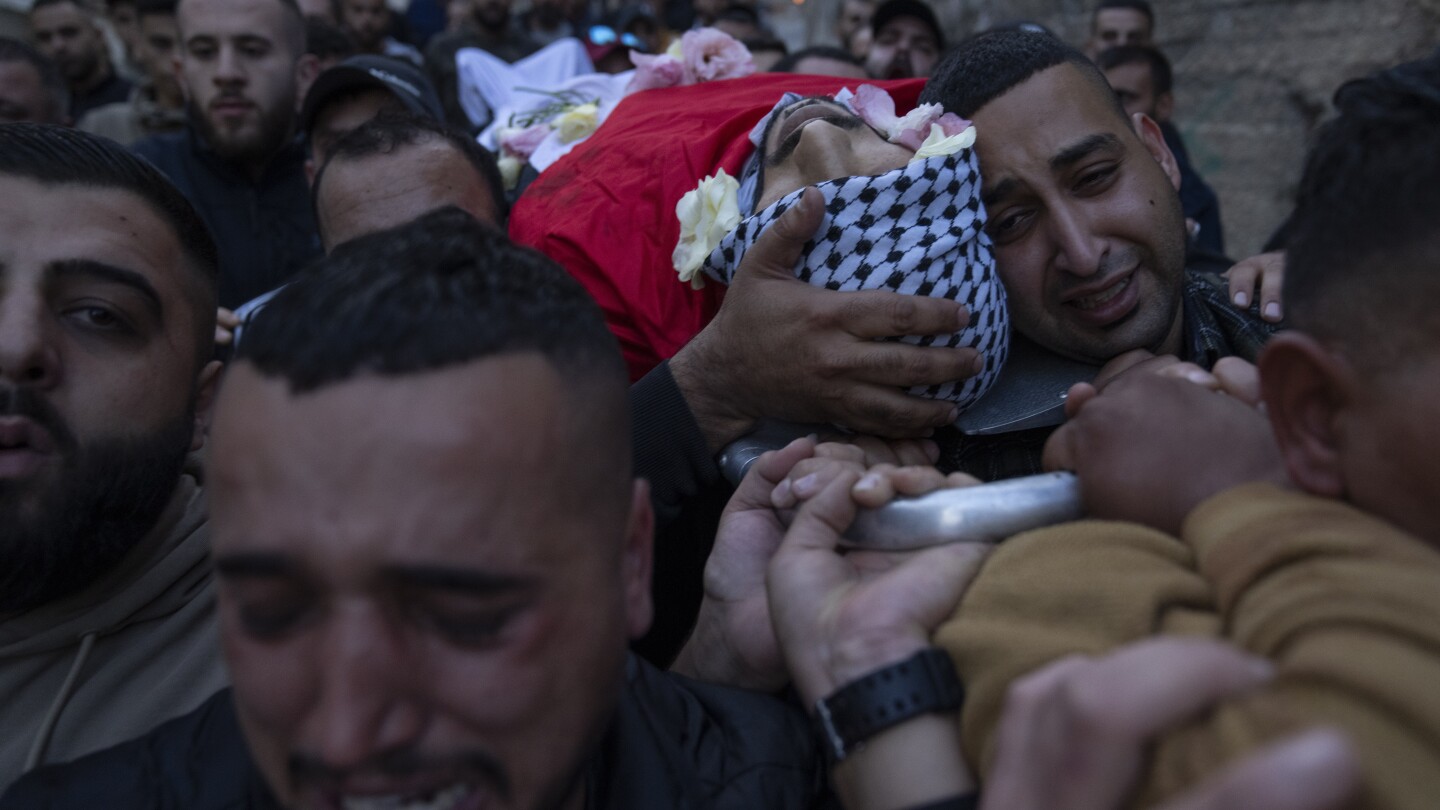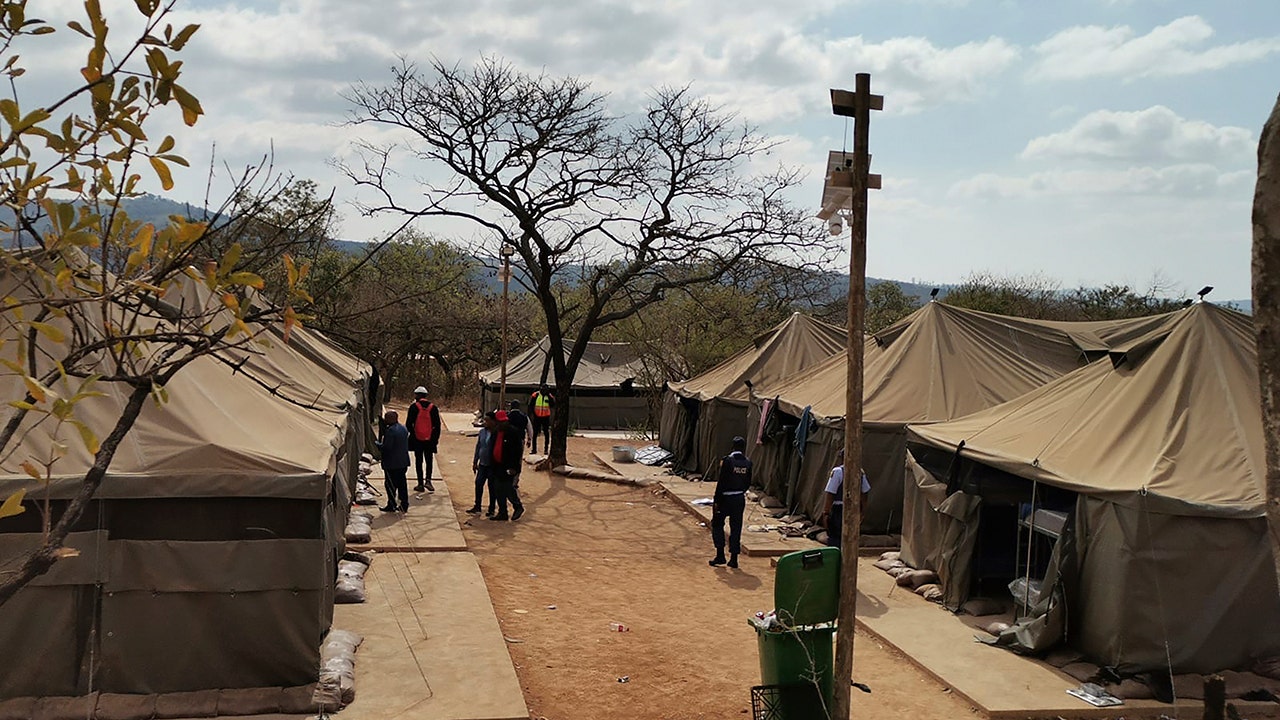World
Israel strikes in and around Gaza’s second largest city in an already bloody new phase of the war

KHAN YOUNIS, Gaza Strip (AP) — Israel intensified its bombardment in and around Gaza’s second largest city early Tuesday, as ambulances and private cars came racing into a local hospital carrying people wounded in a bloody new phase of the war in Gaza.
Under U.S. pressure to prevent further mass casualties, Israel says it is being more precise as it widens its offensive into southern Gaza after obliterating much of the north. Aerial bombardment and the ground offensive have already driven three-fourths of the territory’s 2.3 million people from their homes.
At the Nasser Hospital in Khan Younis, ambulances brought dozens of wounded people in throughout the night. At one point, a car pulled up and man emerged carrying a young boy in a bloody shirt and whose hand had been blown off.
“Where is the Red Cross? … where is the United Nations?” a woman screamed outside the emergency department. “My children, since 10 p.m., are still under the rubble.”
Satellite photos taken Sunday showed tanks and troops massing outside Khan Younis, the latest target of the offensive, which was home to more than 400,000 people before the war.
Israel has ordered people out of nearly two dozen neighborhoods instead of the entire region, as it did in the north. But with most of Gaza’s population already packed into the south, cramming U.N. shelters and family homes, there are few places left to go. Israel has barred people who fled the north earlier in the war from returning.
Palestinians say that as Israel continues to strike across the besieged territory, there are no areas where they feel safe, and many fear that if they leave their homes they will never be allowed to return.
THE QUEST TO ELIMINATE HAMAS
Israel says it must dismantle Hamas’ extensive military infrastructure and remove it from power in order to prevent a repeat of the Oct. 7 attack that ignited the war. The surprise assault through the border fence saw Hamas and other Palestinian militants kill about 1,200 people, mostly civilians, and capture some 240 men, women and children.
The Israeli military says it makes every effort to spare civilians and accuses Hamas of using them as human shields as it fights in dense residential areas, where it has a labyrinth of tunnels, bunkers, rocket launchers and sniper nests.
But the militant group is deeply rooted in Palestinian society, and its determination to end decades of open-ended Israeli military rule is shared by most Palestinians, even those opposed to its ideology and its attacks on Israeli civilians. That will complicate any effort to eliminate Hamas without causing massive casualties and displacement.
Even after weeks of unrelenting bombardment, Hamas’ leaders in Gaza were able to conduct complex cease-fire negotiations and orchestrate the release of more than 100 Israeli and foreign hostages in exchange for 240 Palestinian prisoners last week. Palestinian militants have also kept up their rocket fire into Israel, both before and after the truce.
The fighting has meanwhile brought unprecedented death and destruction to the coastal strip.
The Health Ministry in Gaza said the death toll in the territory since Oct. 7 has surpassed 15,890 people – 70% of them women and children — with more than 42,000 wounded. The ministry does not differentiate between civilian and combatant deaths. It says hundreds have been killed or wounded since the cease-fire’s end, and many still are trapped under rubble.
An Israeli army official provided a similar figure for the death toll in Gaza on Monday, after weeks in which Israeli officials had cast doubt on the ministry’s count. The official said at least 15,000 people have been killed, including 5,000 militants, without saying how the military arrived at its figures. The military says 84 of its soldiers have been killed in the Gaza offensive.
White House national security adviser Jake Sullivan said Monday that it was too soon to pass judgment on Israeli operations, but that it was unusual for a modern military to identify precise areas of expected ground maneuvers and ask people to move out, as Israel has done in Khan Younis.
“These are the kinds of steps that we have asked them to undertake.” he said. “These are the conversations we’re having day in, day out.”
The U.S. has pledged unwavering support to Israel since the Oct. 7 attack, including rushing weapons and other aid to the country.
Airstrikes and the ground offensive in northern Gaza have reduced large swaths of Gaza City and nearby areas to a rubble-filled wasteland. Hundreds of thousands of residents fled south during the assault.
Now around 2 million people — most of the territory’s population — are crowded into the 230 square kilometers (90 square miles) of southern and central Gaza. Since the truce’s collapse, the military has ordered the population out of an area of about 62 square kilometers (24 square miles) in and near Khan Younis, according to the evacuation maps issued by the Israeli military.
That further reduces the space available for Palestinians by more than a quarter.
KHAN YOUNIS IN THE CROSSHAIRS
Satellite photos from Sunday, analyzed by The Associated Press early Tuesday, show around 150 Israeli tanks, armored personnel carriers and other vehicles just under 6 kilometers (3.7 miles) north of the heart of Khan Younis. The army did not respond to a request for comment and rarely publicizes troop deployments.
Constant bombardment on the edge of Khan Younis lit up the sky over the town Monday evening.
Over the past few days, Israeli strikes have been “on a ferocious scale,” said Mohammed Aghaalkurdi, an aid worker with the group Medical Aid for Palestinians in Khan Younis.
He said neighborhoods and shelters were emptying as people fled. Leaflets dropped by the Israeli military warn people to go south toward the border with Egypt, but they are unable to leave Gaza, as both Israel and neighboring Egypt have refused to accept any refugees.
Adding to the chaos, phone and internet networks across Gaza collapsed again Monday evening, the Palestinian telecom provider PalTel said. It was the latest of several outages that have complicated rescue efforts. Communications were restored hours later.
The area that Israel ordered evacuated covers about a fifth of Khan Younis. Before the war, that area was home to some 117,000 people, and now it also houses more than 50,000 people displaced from the north, living in 21 shelters, the U.N. said. It was not known how many were fleeing.
Israeli media also reported intense fighting between Israeli troops and Hamas militants in northern Gaza — in the Jabaliya refugee camp, a built-up urban area, and in the Gaza City district of Shijaiya, both of which have seen intense bombardment and battles in recent weeks.
___
Magdy reported from Cairo. Associated Press writer Jon Gambrell in Dubai, United Arab Emirates, contributed.
___
Full AP coverage at https://apnews.com/hub/israel-hamas-war.

World
Celine Dion Makes Triumphant Comeback at Paris Olympics Opening Ceremony — Watch Full Performance

ad
World
95 Libyan nationals arrested in South Africa at suspected secret military training camp

South African police arrested 95 Libyan nationals in a raid on a suspected secret military training camp on Friday and authorities said they were investigating whether there were more illegal bases in other parts of the country.
The camp was discovered at a farm in White River in the Mpumalanga province, about 360 kilometers (220 miles) northeast of Johannesburg, police said.
ELEPHANTS KILL TOURIST IN SOUTH AFRICA AFTER HE TRIED TO GET CLOSE TO TAKE PICTURES
National police spokesperson Athlenda Mathe said in a post on the social media site X that the Libyans stated they had entered the country on study visas to train as security guards, but police investigations suggest they have received military training.
The Newzroom Afrika TV news channel broadcast pictures of the site of the arrests, showing a military-style camp with large green and khaki tents set up in a row. Dozens of men were seen lining up as they were arrested. They were wearing civilian clothing.
Local government official Jackie Macie said investigations were ongoing and the owner of the farm would be questioned. He said authorities received information that there were similar secret camps near two other towns in Mpumalanga province.
A camp where 95 Libyan nationals were arrested on suspicion of running an illegal military camp are seen lining up after their arrest on Friday, July 26, 2024 in White River, South Africa. Police say that 95 Libyan nationals were arrested on suspicion of receiving training at a secret military camp in the north of the country. (AP Photo/Bulelwa Maphanga)
The province borders neighboring countries Mozambique and Swaziland and is an area of concern for South African authorities with regards to illegal immigration.
Police and authorities have not said whether the camps are suspected of being connected to a particular group or conflict.
Macie said investigations would establish if there was a network of camps in South Africa and show “why they are here doing military training in our country.”
Police said the men may be linked to crimes reported in communities close to the farm in recent months.
“We have serious cases which have been opened with the police, including cases of rape and armed robberies, which complainants claim were committed by unknown foreigners who seem to be of Asian descent,” said police spokesman Donald Mdhluli.
“We take what we have found here today very seriously because we don’t know who was training them, what were they being trained for and why that training is happening here in South Africa. It may be a threat not only to South Africa but also to the entire southern Africa region.”
Police said the operation to arrest the Libyans and close down the camp began two days ago. Macie said the Libyan nationals had been in the country since at least April.
“The 95 individuals taken into custody are all Libyan nationals and are currently being questioned by the relevant authorities,” Mpumalanga acting provincial police commissioner Maj. Gen. Zeph Mkhwanazi said in a statement.
Mdhluli, the police spokesman, said the country’s security regulator had confirmed that the kind of training that appears to have been taking place at the camp was well beyond the scope of training for security guards.
“The kind of equipment we found here shows that there was intense military training taking place here. This was basically a military base.”
World
Passengers face long, uncertain wait at stations amid rail disruption

A deliberate fire in a signal box about 60 km south of Lille caused the disruption on the northern high-speed line, with traffic halted around 5 a.m. local time on Friday.
Travel was severely disrupted in Lille on Friday, one of the stations affected by the sabotage that hit major French rail lines ahead of the Paris Olympics opening ceremony.
Many passengers waited with hope that soon turned to resignation.
“We’ve been waiting since 10:38 a.m. for the 11:38 a.m. train, and now we’re just waiting for it to arrive at 2:08 p.m.,” said Delphine, one of the stranded passengers.
“It’s still quite a delay, and we’ll be even later since we’re on a secondary route. I work in Avignon at 9 p.m., so it’s going to be very, very tight. We have a concert tonight — will it even happen? This is all very confusing, and we don’t understand what’s going on.”
For one traveller, this was a rough start to the holidays. “The worst case would be if the train is cancelled entirely and we have to buy new tickets for next week. It would shorten our already brief vacation. That would be a huge problem,” said Hippolyte.
When asked if he had been informed of the delays, Hippolyte said he received the notification just before departure.
“At around 10 a.m. this morning, we were told we were an hour late and would be leaving at 1 p.m.”
“It just keeps getting later as the day goes on. Every time we approach the new departure time, it gets pushed back another hour and a half, or half an hour each time.”
A deliberate fire in a signal box about 60 km south of Lille caused the disruption on the northern high-speed line. Traffic was halted around 5 a.m. on Friday.
The recent acts of sabotage on the rail network highlight that the Olympic Games are turning France into a prime target.
The attack disrupted the transport system on the opening day of the Games, causing delays of up to two hours or even cancellations that affected hundreds of thousands of passengers nationwide.
Authorities in Paris have said they are deploying substantial human resources to counter any threats and to ensure the safety of the events.
-

 World1 week ago
World1 week agoOne dead after car crashes into restaurant in Paris
-

 Midwest1 week ago
Midwest1 week agoMichigan rep posts video response to Stephen Colbert's joke about his RNC speech: 'Touché'
-

 News1 week ago
News1 week agoVideo: Young Republicans on Why Their Party Isn’t Reaching Gen Z (And What They Can Do About It)
-

 Movie Reviews1 week ago
Movie Reviews1 week agoMovie Review: A new generation drives into the storm in rousing ‘Twisters’
-

 News1 week ago
News1 week agoIn Milwaukee, Black Voters Struggle to Find a Home With Either Party
-

 Politics1 week ago
Politics1 week agoFox News Politics: The Call is Coming from Inside the House
-

 News1 week ago
News1 week agoVideo: J.D. Vance Accepts Vice-Presidential Nomination
-

 World1 week ago
World1 week agoTrump to take RNC stage for first speech since assassination attempt

















